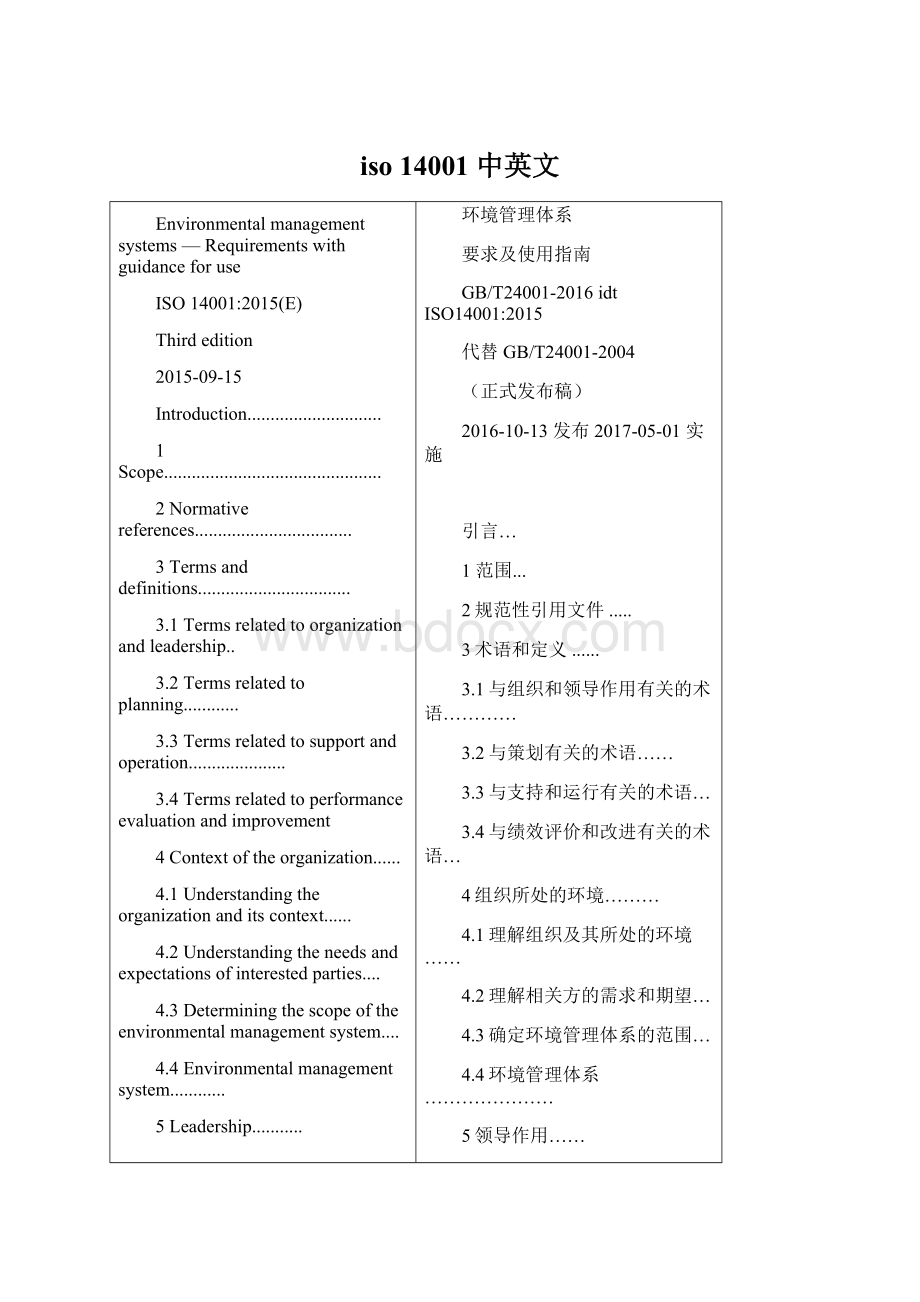iso 14001中英文.docx
《iso 14001中英文.docx》由会员分享,可在线阅读,更多相关《iso 14001中英文.docx(74页珍藏版)》请在冰豆网上搜索。

iso14001中英文
Environmentalmanagementsystems—Requirementswithguidanceforuse
ISO14001:
2015(E)
Thirdedition
2015-09-15
Introduction.............................
1Scope...............................................
2Normativereferences..................................
3Termsanddefinitions.................................
3.1Termsrelatedtoorganizationandleadership..
3.2Termsrelatedtoplanning............
3.3Termsrelatedtosupportandoperation.....................
3.4Termsrelatedtoperformanceevaluationandimprovement
4Contextoftheorganization......
4.1Understandingtheorganizationanditscontext......
4.2Understandingtheneedsandexpectationsofinterestedparties....
4.3Determiningthescopeoftheenvironmentalmanagementsystem....
4.4Environmentalmanagementsystem............
5Leadership...........
5.1Leadershipandcommitment........
5.2Environmentalpolicy.......................
5.3Organizationalroles,responsibilitiesandauthorities.
6Planning.
6.1Actionstoaddressrisksandopportunities...
6.1.1General................
6.1.2Environmentalaspects........
6.1.3Complianceobligations.........
6.1.4Planningaction................
6.2Environmentalobjectivesandplanningtoachievethem....
6.2.1Environmentalobjectives........
6.2.2Planningactionstoachieveenvironmentalobjectives...
7Support............
7.1Resources.............
7.2Competence.................
7.3Awareness...................
7.4Communication............
7.4.1General......................
7.4.2Internalcommunication..........
7.4.3Externalcommunication...........
7.5Documentedinformation................
7.5.1General.................
7.5.2Creatingandupdating..............
7.5.3Controlofdocumentedinformation......
8Operation.....
8.1Operationalplanningandcontrol...........
8.2Emergencypreparednessandresponse.....
9Performanceevaluation.............
9.1Monitoring,measurement,analysisandevaluation........
9.1.1General.............
9.1.2Evaluationofcompliance..........
9.2Internalaudit......................
9.2.1General....................
9.2.2Internalauditprogramme..........
9.3Managementreview................
10Improvement................
10.1General...................
10.2Nonconformityandcorrectiveaction
10.3Continualimprovement..........
AnnexA(informative)GuidanceontheuseofthisInternationalStandard.
AnnexB(informative)CorrespondencebetweenISO14001:
2015andISO14001:
2004..(略)
Bibliography..................
Introduction
0.1Background
Achievingabalancebetweentheenvironment,societyandtheeconomyisconsideredessentialtomeettheneedsofthepresentwithoutcompromisingtheabilityoffuturegenerationstomeettheirneeds.Sustainabledevelopmentasagoalisachievedbybalancingthethreepillarsofsustainability.
Societalexpectationsforsustainabledevelopment,transparencyandaccountabilityhaveevolvedwithincreasinglystringentlegislation,growingpressuresontheenvironmentfrompollution,inefficientuseofresources,improperwastemanagement,climatechange,degradationofecosystemsandlossofbiodiversity.
Thishasledorganizationstoadoptasystematicapproachtoenvironmentalmanagementbyimplementingenvironmentalmanagementsystemswiththeaimofcontributingtotheenvironmentalpillarofsustainability.
0.2Aimofanenvironmentalmanagementsystem
ThepurposeofthisInternationalStandardistoprovideorganizationswithaframeworktoprotecttheenvironmentandrespondtochangingenvironmentalconditionsinbalancewithsocio-economicneeds.Itspecifiesrequirementsthatenableanorganizationtoachievetheintendedoutcomesitsetsforitsenvironmentalmanagementsystem.
Asystematicapproachtoenvironmentalmanagementcanprovidetopmanagementwithinformationtobuildsuccessoverthelongtermandcreateoptionsforcontributingtosustainabledevelopmentby:
—protectingtheenvironmentbypreventingormitigatingadverseenvironmentalimpacts;
—mitigatingthepotentialadverseeffectofenvironmentalconditionsontheorganization;
—assistingtheorganizationinthefulfilmentofcomplianceobligations;
—enhancingenvironmentalperformance;
—controllingorinfluencingthewaytheorganization’sproductsandservicesaredesigned,manufactured,distributed,consumedanddisposedbyusingalifecycleperspectivethatcanpreventenvironmentalimpactsfrombeingunintentionallyshiftedelsewherewithinthelifecycle;
—achievingfinancialandoperationalbenefitsthatcanresultfromimplementingenvironmentallysoundalternativesthatstrengthentheorganization’smarketposition;
—communicatingenvironmentalinformationtorelevantinterestedparties.
ThisInternationalStandard,likeotherInternationalStandards,isnotintendedtoincreaseorchangeanorganization’slegalrequirements.
0.3Successfactors
Thesuccessofanenvironmentalmanagementsystemdependsoncommitmentfromalllevelsandfunctionsoftheorganization,ledbytopmanagement.Organizationscanleverageopportunitiestopreventormitigateadverseenvironmentalimpactsandenhancebeneficialenvironmentalimpacts,particularlythosewithstrategicandcompetitiveimplications.Topmanagementcaneffectivelyaddressitsrisksandopportunitiesbyintegratingenvironmentalmanagementintotheorganization’sbusinessprocesses,strategicdirectionanddecisionmaking,aligningthemwithotherbusinesspriorities,andincorporatingenvironmentalgovernanceintoitsoverallmanagementsystem.DemonstrationofsuccessfulimplementationofthisInternationalStandardcanbeusedtoassureinterestedpartiesthataneffectiveenvironmentalmanagementsystemisinplace.
AdoptionofthisInternationalStandard,however,willnotinitselfguaranteeoptimalenvironmentaloutcomes.ApplicationofthisInternationalStandardcandifferfromoneorganizationtoanotherduetothecontextoftheorganization.Twoorganizationscancarryoutsimilaractivitiesbutcanhavedifferentcomplianceobligations,commitmentsintheirenvironmentalpolicy,environmentaltechnologiesandenvironmentalperformancegoals,yetbothcanconformtotherequirementsofthisInternationalStandard.
Thelevelofdetailandcomplexityoftheenvironmentalmanagementsystemwillvarydependingonthecontextoftheorganization,thescopeofitsenvironmentalmanagementsystem,itscomplianceobligations,andthenatureofitsactivities,productsandservices,includingitsenvironmentalaspectsandassociatedenvironmentalimpacts.
0.4Plan-Do-Check-Actmodel
ThebasisfortheapproachunderlyinganenvironmentalmanagementsystemisfoundedontheconceptofPlan-Do-Check-Act(PDCA).ThePDCAmodelprovidesaniterativeprocessusedbyorganizationstoachievecontinualimprovement.Itcanbeappliedtoanenvironmentalmanagementsystemandtoeachofitsindividualelements.Itcanbebrieflydescribedasfollows.
—Plan:
establishenvironmentalobjectivesandprocessesnecessarytodeliverresultsinaccordancewiththeorganization’senvironmentalpolicy.
—Do:
implementtheprocessesasplanned.
—Check:
monitorandmeasureprocessesagainsttheenvironmentalpolicy,includingitscommitments,environmentalobjectivesandoperatingcriteria,andreporttheresults.
—Act:
takeactionstocontinuallyimprove.
Figure1showshowtheframeworkintroducedinthisInternationalStandardcouldbeintegratedintoaPDCAmodel,whichcanhelpnewandexistinguserstounderstandtheimportanceofasystemsapproach.
Figure1—RelationshipbetweenPDCAandtheframeworkinthisInternationalStandard
0.5ContentsofthisInternationalStandard
ThisInternationalStandardconformstoISO’srequirementsformanagementsystemstandards.Theserequirementsincludeahighlevelstructure,identicalcoretext,andcommontermswithcoredefinitions,designedtobenefitusersimplementingmultipleISOmanagementsystemstandards.
ThisInternationalStandarddoesnotincluderequirementsspecifictoothermanagementsystems,suchasthoseforquality,occupationalhealthandsafety,energyorfinancialmanagement.However,thisInternationalStandardenablesanorganizationtouseacommonapproachandrisk-basedthinkingtointegrateitsenvironmentalmanagementsystemwiththerequirementsofothermanagementsystems.
ThisInternationalStandardcontainstherequirementsusedtoassessconformity.AnorganizationthatwishestodemonstrateconformitywiththisInternationalStandardcandosoby:
—makingaself-determinationandself-declaration,or
—seekingconfirmationofitsconformancebypartieshavinganinterestintheorganization,suchascustomers,or
—seekingconfirmationofitsself-declarationbyapartyexternaltotheorganization,or
—seekingcertification/registrationofitsenvironmentalmanagementsystembyanexternalorganization.
AnnexAprovidesexplanatoryinformationtopreventmisinterpretationoftherequirementsofthisInternationalStandard.AnnexBshowsbroadtechnicalcorrespondencebetweenthepreviouseditionofthisInternationalStandardandthisedition.ImplementationguidanceonenvironmentalmanagementsystemsisincludedinISO14004.
InthisInternationalStandard,thefollowingverbalformsareused:
—“shall”indicatesarequirement;
—“should”indicatesarecommendation;
—“may”indicatesapermission;
—“can”indicatesapossibilityoracapability.
Informationmarkedas“NOTE”isintendedtoassisttheunderstandingoruseofthedocument.“Notestoentry”usedinClause3provideadditionalinformationthatsupplementstheterminologicaldataandcancontainprovisionsrelatingtotheuseofaterm.
ThetermsanddefinitionsinClause3arearrangedi